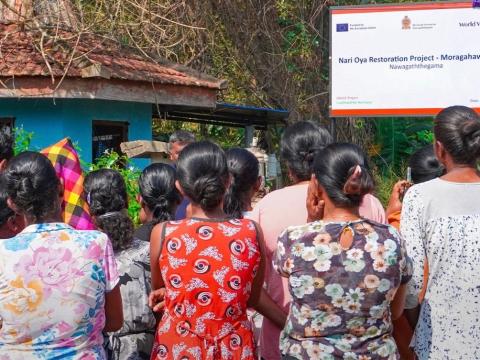A Future Without Floods

“This is the first time the floods did not hit us.” Said, Indika Lal, a resident of Nawagattegama a village that suffers from floods and droughts throughout the year.
Ralapanawa Canal plays a pivotal role as the primary water source for paddy cultivation in this rural area. The livelihoods of farmers hinge on this canal, but neglect due to insufficient funds has left it uncleared for years. When floods strike, the consequences are severe for these farmers. The impact of floods extends beyond physical damage to cultivation, housing, and livelihoods. It also triggers social conflicts related to the distribution of relief goods and funds.
“We don’t have enough facilities in the school for a relief center. It's just a building with desks, chairs, and a roof above.” Indika Lal explained that women and children become more vulnerable to hygiene and health issues during and after floods in these relief centers. “The school has to stop the usual teaching to provide shelter for the displaced.” Explained Indika Lal.
Priyadarshini, an officer at the National Disaster Relief Service Center in Nawagattegama, sheds light on the challenges faced during floods. “With each rain, the canal overflows, disrupting the lives of everyone in the area. Thirty families are displaced during each flood, losing their regular income. It takes weeks for them to settle, during which we provide shelter, food, and sanitation facilities. However, the underlying caste issues emerge when all the displaced people are together in one relief center. Providing for them separately becomes a challenge,” she explains.
However, the Grace Project, funded by the European Union, stepped in to collaborate with the local government and the people of Nawagattegama to mitigate flood risks. “I participated in the training sessions conducted by the Grace project before the proposal development, and then we had several discussions and field visits to farmers and villages with the National Disaster Relief Center officer,” said enthusiastic Ruwan Rajapaksha, Grama Sevaka of the Nawagattegama area who was actively engaged throughout the implementation process of the canal cleaning project.
The enormous support of the community is notable for the conservation of the canal banks by planting trees along the forest reserve, enhancing natural habitats and environmental protection, and fostering a more resilient community at Nawagattegama. The approach goes beyond flood prevention—it addresses both natural and human conflicts in the area. “many have not gone out of the area to get exposed to the possibilities of life. They need a little push. Thanks to the European Union and World Vision for helping these people. We saw the results in no time after the implementation of the project” said Priyadarshani.
The Grace Project has been a beacon of hope for the people of Nawagattegama, releasing them from the grief that had haunted their memories for years. The spill from the two tanks of Ralapanawa now finds its way down to the Thabbowa tank through the Nari oya during the monsoon seasons of “Yala” (from May to August) and “Maha” (from October to January).
Remarkably, this is the first time the locals haven’t had to seek refuge in relief centers during floods.